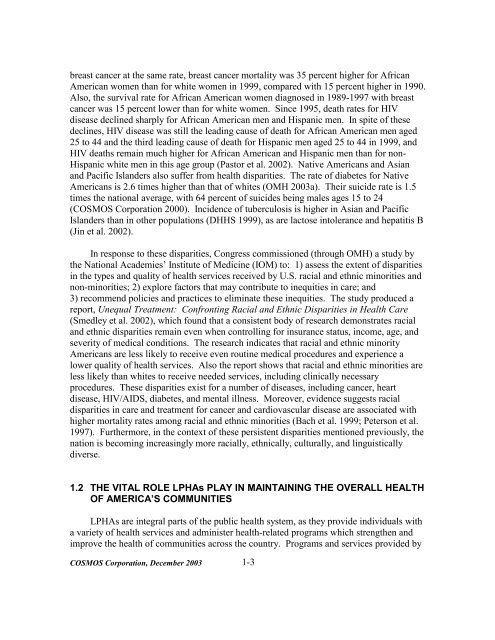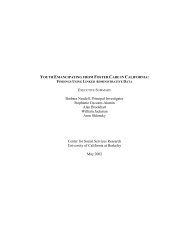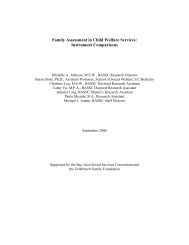east cancer at the same rate, breast cancer mortality was 35 percent higher for AfricanAmerican women than for white women in 1999, compared with 15 percent higher in 1990.Also, the survival rate for African American women diagnosed in 1989-1997 with breastcancer was 15 percent lower than for white women. Since 1995, death rates for HIVdisease declined sharply for African American men and Hispanic men. In spite <strong>of</strong> thesedeclines, HIV disease was still the leading cause <strong>of</strong> death for African American men aged25 to 44 and the third leading cause <strong>of</strong> death for Hispanic men aged 25 to 44 in 1999, andHIV deaths remain much higher for African American and Hispanic men than for non-Hispanic white men in this age group (Pastor et al. 2002). Native Americans and Asianand Pacific Islanders also suffer from health disparities. The rate <strong>of</strong> diabetes for NativeAmericans is 2.6 times higher than that <strong>of</strong> whites (OMH 2003a). Their suicide rate is 1.5times the national average, with 64 percent <strong>of</strong> suicides being males ages 15 to 24(COSMOS Corporation 2000). Incidence <strong>of</strong> tuberculosis is higher in Asian and PacificIslanders than in other populations (DHHS 1999), as are lactose intolerance and hepatitis B(Jin et al. 2002).In response to these disparities, Congress commissioned (through OMH) a study bythe National Academies’ Institute <strong>of</strong> Medicine (IOM) to: 1) assess the extent <strong>of</strong> disparitiesin the types and quality <strong>of</strong> health services received by U.S. racial and ethnic minorities andnon-minorities; 2) explore factors that may contribute to inequities in care; and3) recommend policies and practices to eliminate these inequities. The study produced areport, Unequal Treatment: Confronting Racial and Ethnic Disparities in Health Care(Smedley et al. 2002), which found that a consistent body <strong>of</strong> research demonstrates racialand ethnic disparities remain even when controlling for insurance status, income, age, andseverity <strong>of</strong> medical conditions. The research indicates that racial and ethnic minorityAmericans are less likely to receive even routine medical procedures and experience alower quality <strong>of</strong> health services. Also the report shows that racial and ethnic minorities areless likely than whites to receive needed services, including clinically necessaryprocedures. These disparities exist for a number <strong>of</strong> diseases, including cancer, heartdisease, HIV/AIDS, diabetes, and mental illness. Moreover, evidence suggests racialdisparities in care and treatment for cancer and cardiovascular disease are associated withhigher mortality rates among racial and ethnic minorities (Bach et al. 1999; Peterson et al.1997). Furthermore, in the context <strong>of</strong> these persistent disparities mentioned previously, thenation is becoming increasingly more racially, ethnically, culturally, and linguisticallydiverse.1.2 THE VITAL ROLE LPHAs PLAY IN MAINTAINING THE OVERALL HEALTHOF AMERICA’S COMMUNITIESLPHAs are integral parts <strong>of</strong> the public health system, as they provide individuals witha variety <strong>of</strong> health services and administer health-related programs which strengthen andimprove the health <strong>of</strong> communities across the country. Programs and services provided byCOSMOS Corporation, December 2003 1-3
LPHAs include: adult and child immunizations, communicable disease control,community assessment, community outreach and education, environmental health services,epidemiology and surveillance, food safety, health education, restaurant inspections, andtuberculosis testing. In addition, some LPHAs provide primary care or direct medical careservices, including treatment for chronic diseases such as cardiovascular disease ordiabetes, behavioral or mental health services, programs for homeless, and veterinarypublic health (NACCHO 2001).LPHAs serve as safety net providers, ensuring health care for vulnerable and at-riskpopulations. Populations served by LPHAs include the uninsured, racial and ethnicminorities, persons with LEP, those with low income, the homeless, migrant workers, andothers with unique or special language and cultural needs (Brown et al. 2000; KaiserCommission on Medicaid and the Uninsured 2000; Ku and Freilich 2001). Thecharacteristics <strong>of</strong> the at-risk populations served by LPHAs make the provision <strong>of</strong> CLASimperative. For instance, a study found that more than 50 percent <strong>of</strong> low-incomeimmigrants have no health insurance and rely on LPHAs for care (Ku and Freilich 2001),and racial and ethnic minorities are twice as likely to be uninsured as whites (Collins et al.2002; Commonwealth Fund 1996). In addition, studies show that racial and ethnicminorities are less likely to have a regular primary care provider or health insurance(Collins et al. 2002), thus having to rely on health services provided by LPHAs. Also,recent immigrants with LEP who are unfamiliar with the U.S. health care system are, forthe most part, not eligible for Medicaid or Medicare, which makes them more likely to beuninsured, to lack a regular provider, and to seek health care at a LPHA (CommonwealthFund 1994, 1996).1.3 LPHAs’ PROVISION OF CLAS COULD LEAD TO IMPROVED HEALTHOUTCOMESLPHAs directly impact the health <strong>of</strong> individuals and empower communities to achievebetter health by providing essential health services within jurisdictions (NACCHO 2001).The ultimate goals <strong>of</strong> providing CLAS are to make the local public health care system moreresponsive to the needs <strong>of</strong> all clients and to increase their satisfaction with and access tohigh quality health care; decrease inappropriate differences in the characteristics andquality <strong>of</strong> care provided; and close the gaps in health status across diverse populationswithin the country (Anderson et al. 2003). The ten essential public health services listedCOSMOS Corporation, December 2003 1-4
- Page 1 and 2: Developing a Self-Assessment Toolfo
- Page 3 and 4: ContentsChaptersPage1. Introduction
- Page 5 and 6: Chapter 1Introduction
- Page 7: While many LPHAs currently provide
- Page 11 and 12: Professions Education Partnership A
- Page 13 and 14: Chapter 2Methodology for Developing
- Page 15 and 16: Public Health Practice Program Offi
- Page 17 and 18: assess their own beliefs and have k
- Page 19 and 20: communicate with, and clearly under
- Page 21 and 22: 2.1.6 Identifying Key Components of
- Page 23 and 24: Given these persistent disparities
- Page 25 and 26: (Exhibit 2-2, Continued)DOMAIN / KE
- Page 27 and 28: limited to the actual clinical enco
- Page 29 and 30: Chapter 3Project Results and Recomm
- Page 31 and 32: local board of health. PEP and PAG
- Page 33 and 34: numerous promising CLAS practices a
- Page 35 and 36: References
- Page 37 and 38: Becker, M.H., and L.A. Maiman, “S
- Page 39 and 40: Frye, B., “Health Care Decision M
- Page 41 and 42: Marin, G., “Defining Culturally A
- Page 43 and 44: Perkins, Jane, “Overcoming Langua
- Page 45 and 46: U.S. Bureau of the Census, “Censu
- Page 47 and 48: Appendix AMembership Lists of the P
- Page 49 and 50: Appendix A-1Developing a Self-Asses
- Page 51 and 52: Appendix A-2Developing a Self-Asses
- Page 53 and 54: Appendix B-1Overview of Eight CLAS
- Page 55 and 56: Domain 3: Culturally Inclusive Heal
- Page 57 and 58: understanding of diversity issues i
- Page 59 and 60:
Appendix B-2Conceptual Framework fo
- Page 61 and 62:
Appendix CLPHA Director or Designee
- Page 63 and 64:
Pre-Interview Script for LPHA Direc
- Page 65 and 66:
3b. Which of the following are refl
- Page 67 and 68:
6. Does your agency have a formal p
- Page 69 and 70:
10. Which of the following describe
- Page 71 and 72:
Post-Interview Script for LPHA Dire
- Page 73 and 74:
Appendix DStaffing Questionnaire
- Page 75 and 76:
A. QUALITY MONITORING AND IMPROVEME
- Page 77 and 78:
B. MANAGEMENT INFORMATION SYSTEMS (
- Page 79 and 80:
7. Please indicate, if you know, th
- Page 81 and 82:
1c. Please indicate for which categ
- Page 83 and 84:
6. Please indicate for which catego
- Page 85 and 86:
10. Which of the following topical
- Page 87 and 88:
17. Which of the following benefits
- Page 89 and 90:
4. Which of the following strategie
- Page 91 and 92:
Appendix EClient Services Questionn
- Page 93 and 94:
A. QUALITY MONITORING AND IMPROVEME
- Page 95 and 96:
6b.Which of the following community
- Page 97 and 98:
3. Please report or estimate what p
- Page 99 and 100:
3. Which of the following practices
- Page 101 and 102:
Oral Interpretation Services10. Whi
- Page 103 and 104:
16. At which of the following key e
- Page 105 and 106:
3. Which of the following kinds of
- Page 107 and 108:
Appendix FPilot Test Response Form
- Page 109 and 110:
RESPONDENT EVALUATIONOF THE QUESTIO
- Page 111 and 112:
Appendix GCLAS in MCOs Study Data C
- Page 113 and 114:
position, as titles will likely var
- Page 115 and 116:
complex and uncertain at the time t
- Page 117 and 118:
1. Incorporate a confirmation pre-c
- Page 119 and 120:
Exhibit 2DATA COLLECTION PROCESSSen
















